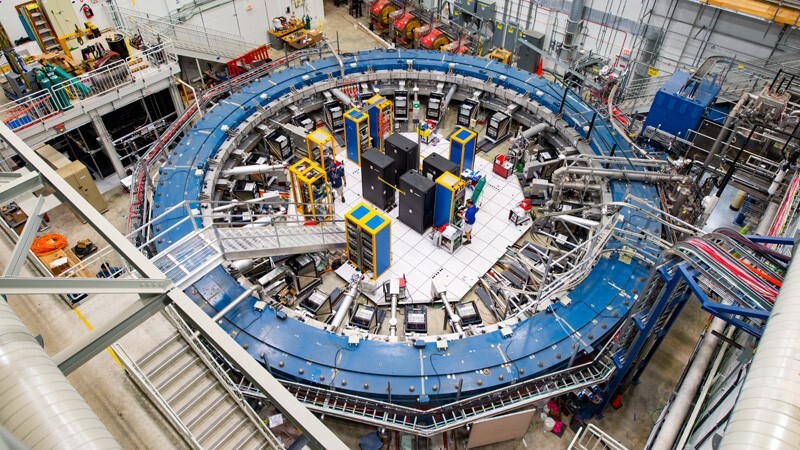A tiny, wobbling muon just shook particle physics to its core
But this may not be the end of the story.

The results from one of the most hotly-anticipated experiments in particle physics are in, and they could be about to fulfill every researcher's wildest dreams: They maybe, perhaps, could break physics as we know it.
Evidence taken from the Fermi National Accelerator Laboratory near Chicago appears to point to a miniscule subatomic particle known as the muon wobbling far more than theory predicts it should. The best explanation, according to physicists, is that the muon is being pushed about by types of matter and energy completely unknown to physics.
If the results are true, the discovery represents a breakthrough in particle physics of a kind that hasn't been seen for 50 years, when the dominant theory to explain subatomic particles was first developed. The teeny-tiny wobble of the muon — created by the interaction of its intrinsic magnetic field, or magnetic moment, with an external magnetic field — could shake the very foundations of science.
"Today is an extraordinary day, long awaited not only by us but by the whole international physics community," Graziano Venanzoni, co-spokesperson of the Muon g-2 experiment and physicist at the Italian National Institute for Nuclear Physics, said in a statement.
Related: Beyond Higgs: 5 elusive particles that may lurk in the universe
Sometimes known as "fat electrons," muons are similar to their more widely-known cousins but are 200 times heavier and radioactively unstable — decaying in mere millionths of a second into electrons and tiny, ghostly, chargeless particles known as neutrinos. Muons also have a property called spin which, when combined with their charge, makes them behave as if they were tiny magnets, causing them to wobble like little gyroscopes when plopped inside a magnetic field.
But today's results, which came from an experiment in which physicists sent muons whizzing around a superconducting magnetic ring, seem to show that the muon is wobbling far more than it should be. The only explanation, the study scientists said, is the existence of particles not yet accounted for by the set of equations that explain all subatomic particles, called the Standard Model — which has remained unchanged since the mid-1970s. Those exotic particles and the associated energies, the idea goes, would be nudging and tugging at the muons inside the ring.
Sign up for the Live Science daily newsletter now
Get the world’s most fascinating discoveries delivered straight to your inbox.
The Fermilab researchers are relatively confident that what they saw (the extra wobbling) was a real phenomenon and not some statistical fluke. They put a number on that confidence of "4.2 sigma," which is incredibly close to the 5 sigma threshold at which particle physicists declare a major discovery. (A 5-sigma result would suggest there's a 1 in 3.5 million chance that it happened due to chance.)
"This quantity we measure reflects the interactions of the muon with everything else in the universe. But when the theorists calculate the same quantity, using all of the known forces and particles in the Standard Model, we don't get the same answer," Renee Fatemi, a physicist at the University of Kentucky and the simulations manager for the Muon g-2 experiment, said in a statement. "This is strong evidence that the muon is sensitive to something that is not in our best theory."
However, a rival calculation made by a separate group and published Wednesday (April 7) in the journal Nature could rob the wobble of its significance. According to this team's calculations, which give a much larger value to the most uncertain term in the equation that predicts the muon's rocking motion, the experimental results are totally in line with predictions. Twenty years of particle chasing could have all been for nothing.
"If our calculations are correct and the new measurements do not change the story, it appears that we don't need any new physics to explain the muon's magnetic moment — it follows the rules of the Standard Model," Zoltan Fodor, a professor of physics at Penn State and a leader of the research team that published the Nature paper, said in a statement.
But Fodor added that, given that his group's prediction relied upon a totally different calculation with very different assumptions, their results were far from being a done deal. "Our finding means that there is a tension between the previous theoretical results and our new ones. This discrepancy should be understood," he said. "In addition, the new experimental results might be close to old ones or closer to the previous theoretical calculations. We have many years of excitement ahead of us."
In essence, physicists won't be able to conclusively say if brand-new particles are tugging on their muons until they can agree exactly how the 17 existing Standard Model particles interact with muons too. Until one theory wins out, physics is left teetering in the balance.
Originally published on Live Science.

Ben Turner is a U.K. based staff writer at Live Science. He covers physics and astronomy, among other topics like tech and climate change. He graduated from University College London with a degree in particle physics before training as a journalist. When he's not writing, Ben enjoys reading literature, playing the guitar and embarrassing himself with chess.









